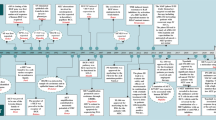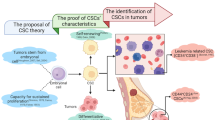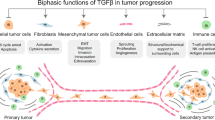ABSTRACT
Tumor progression is a multi-step process that requires a sequential selection of specific malignant phenotypes. Met activation may induce different phenotypes depending on tumor stage: inducing proliferation and angiogenesis in primary tumors, stimulating motility to form micrometastases, and regaining the proliferation phenotype to form overt metastases. To study how HGF/SF-induced proliferative phenotypes switch to the invasive phenotype is important for understanding the mechanism of tumor progression and will provide an attractive target for cancer intervention and therapy.
Similar content being viewed by others
INTRODUCTION
The Met gene encodes the tyrosine kinase receptor for hepatocyte growth factor (HGF)/scatter factor (SF)1. The exposure of Met-expressing cells to HGF/SF can elicit a variety of cellular responses including proliferation, migration, invasion, and branching morphogenesis 2. While HGF/SF-induced cellular effects are required for many normal physiological processes, inappropriate Met activation has been implicated in most types of solid tumors, often correlating with poor prognosis (http://www.vai.org/vari/metandcancer). Since Met signaling contributes to tumor survival, growth, angiogenesis, and metastasis, it provides a potential target for cancer therapy. This review will focus on recent progress on the role of HGF/SF-Met signaling in tumor development and progression.
HGF/SF-MET SIGNALING
Met receptor consists of a 140-kDa membrane-spanning β chain and a 50-kDa extracellular α chain. The two subunits are disulphide-linked to form a 185-kDa heterodimeric complex. The β subunit contains an extracellular portion involved in ligand binding, a membrane-spanning segment, a juxtamembrane domain, a catalytic domain, and a C-terminal docking site 3. The binding of HGF/SF to Met triggers autophosphorylation of the cytoplasmic domain of Met. The phosphorylation at two tyrosine residues in the catalytic domain, Y1234 and Y1235, is crucial for activating Met as a tyrosine kinase, while phosphorylation at Y1349 and Y1356 in the C-terminal docking site is essential for recruiting adaptor proteins 4. Adaptor proteins contain a Src homologous2 (SH2) domain that interacts with Met receptor and a Src homologous3 (SH3) domain that binds to downstream signal molecules.
Grb2 and Ras-MAPK signaling
Grb2 adaptor protein associates with Met through the Grb2 SH2 domain, and Grb2 interacts with SOS1 through its SH3 domains. SOS1 activates Ras, which triggers ERK1/2/MAPK signaling through Ras-Raf-Mek1, 2. This signal pathway has been reported to be involved in HGF/SF-induced cell migration, invasion, and branching morphogenesis 5.
Gab1 and its down stream adaptors
Gab1 binds to Met with its unique Met-binding site 6. Gab1 may also be recruited through Grb2. Activated Met phosphorylates Gab1 at several tyrosine residues that are required for recruiting downstream SH2-domain-containing proteins including PLC-γ, SHP2, Crk/CRKL, Gab1, and PI3K. The functions of the downstream adaptor proteins have been characterized by using Gab1 molecules with mutations at specific tyrosine residues. For example, expression of a Gab1 mutant molecule (Y307/373/407F) that is unable to bind PLC-γ completely abolished HGF/SF-mediated tubulogenesis 7, while a Gab1 mutant at Y673 that fails to recruit SHP2 blocks the sustained ERK1/2 activation and epithelial morphogenesis emanating from Met 8. Both c-Crk and CRKL bind to Tyr-X-X-Pro (YXXP) motifs in Gab1 and recruit C3G and DOCK180 9. C3G is a guanine-nucleotide exchange factor that regulates adherent junction positioning and cell adhesion by activating Rap1 10. DOCK180 activates Rac1, which mediates Met-induced cell spreading and migration 11. PI3K/Akt signaling is required for HGF/SF-induced scattering and branching morphogenesis 12. It is also the main mediator of HGF/SF-induced cell survival 13.
SHIP-1, Src, and Stat3
These proteins directly bind to a Met docking site and mediate different cellular responses. SHIP-1 is required for HGF/SF-mediated branching morphogenesis 14. Src may be involved in HGF/SF-induced cell transformation 3. The activation of Stat3 leads to the expression of genes required for HGF/SF-induced branching morphogenesis or anchorage-independent cell growth 15, 16.
c-Cbl and termination of c-Met signaling
c-Cbl is recruited to the Met receptor by two distinct mechanisms: direct binding to the Met juxtamembrane domain via its TKB domain, and indirect binding through Grb2 via a proline-rich domain. As a ubiquitin-protein ligase, c-Cbl targets Met for ubiquitylation and internalization to terminate Met signaling 17, 18. In addition to the down-regulation of Met protein, Met downstream signaling pathways can be negatively regulated by the HGF/SF-responsive gene product Spry2 19.
ACTIVATION OF HGF/SF-MET SIGNALING IN TUMORS
Met is primarily expressed in epithelial cells, while HGF/SF is produced by surrounding mesenchymal cells. This ligand/receptor-mediated cross-talk between the epithelial and stromal compartments is required for normal physiological processes and is tightly regulated 20. Many tumors constitutively express both HGF/SF and Met to evade spatial and temporal regulatory mechanisms. The autocrine activation of Met occurs in osteosarcomas and glioblastomas, while Met activation in breast cancer, prostate cancer, and lung cancer is believed to be paracrine 2. In tumor cells, Met also can be activated in a ligand-independent manner through Met overexpression or mutation 20. A high level of Met has been described in many carcinomas and is required for maintaining tumor growth and survival 21. In hepatocytes, Met directly binds to Fas and prevents Fas-induced apoptosis in an HGF/SF-independent manner 22. Met mutations in the tyrosine kinase domain have been found in both sporadic and hereditary forms of human papillary renal carcinomas 23. These mutations exhibit increased levels of kinase activity and tumorigenic activity in NIH3T3 cells 24 and give rise to a completely different spectrum of tumors when introduced into the mouse germline 25. Met mutations in the juxtamembrane (JM) domain have been reported in gastric cancer and lung cancer 26, 27. The JM domain is involved in the interaction between Met and c-Cbl. Mutation at this domain prevents down-regulation of Met and leads to extended Met signaling 28.
References
Bottaro DP, Rubin JS, Faletto DL, et al. Identification of the hepatocyte growth factor receptor as the c-met proto-oncogene product. Science 1991; 251:802–4.
Birchmeier C, Birchmeier W, Gherardi E, et al. Met, metastasis, motility and more. Nat Rev Mol Cell Biol 2003; 4:915–25.
Ponzetto C, Bardelli A, Zhen Z, et al. A multifunctional docking site mediates signaling and transformation by the hepatocyte growth factor/scatter factor receptor family. Cell 1994; 77:261–71.
Ferracini R, Longati P, Naldini L, et al. Identification of the major autophosphorylation site of the Met/hepatocyte growth factor receptor tyrosine kinase. J Biol Chem 1991; 266:19558–64.
Maina F, Pante G, Helmbacher F, et al. Coupling Met to specific pathways results in distinct developmental outcomes. Mol Cell 2001; 7:1293–306.
Schaeper U, Gehring NH, Fuchs KP, et al. Coupling of Gab1 to c-Met, Grb2, and Shp2 mediates biological responses. J Cell Biol 2000; 149:1419–32.
Gual P, Giordano S, Williams TA, et al. Sustained recruitment of phospholipase C-gamma to Gab1 is required for HGF-induced branching tubulogenesis. Oncogene 2000; 19:1509–18.
Maroun CR, Naujokas MA, Holgado-Madruga M, et al. The tyrosine phosphatase SHP-2 is required for sustained activation of extracellular signal-regulated kinase and epithelial morphogenesis downstream from the met receptor tyrosine kinase. Mol Cell Biol 2000; 20:8513–25.
Knudsen BS, Feller SM, Hanafusa H . Four proline-rich sequences of the guanine-nucleotide exchange factor C3G bind with unique specificity to the first Src homology 3 domain of Crk. J Biol Chem 1994; 269:32781–7.
Knox AL, Brown NH . Rap1 GTPase regulation of adherens junction positioning and cell adhesion. Science 2002; 295:1285–8.
Kiyokawa E, Hashimoto Y, Kurata T, et al. Evidence that DOCK180 up-regulates signals from the CrkII-p130(Cas) complex. J Biol Chem 1998; 273:24479–84.
Royal I, Park M . Hepatocyte growth factor-induced scatter of Madin-Darby canine kidney cells require phosphatidylinositol 3-kinase. J Biol Chem 1995; 270:27780–7.
Xiao GH, Jeffers M, Bellacosa A, et al. Anti-apoptotic signaling by hepatocyte growth factor/Met via the phosphatidylinositol 3-kinase/Akt and mitogen-activated protein kinase pathways. Proc Natl Acad Sci U S A 2001; 98:247–52.
Stefan M, Koch A, Mancini A, et al. Src homology 2-containing inositol 5-phosphatase 1 binds to the multifunctional docking site of c-Met and potentiates hepatocyte growth factor-induced branching tubulogenesis. J Biol Chem 2001; 276:3017–23.
Boccaccio C, Ando M, Tamagnone L, et al. Induction of epithelial tubules by growth factor HGF depends on the STAT pathway. Nature 1998; 391:285–8.
Zhang YW, Wang LM, Jove R, et al. Requirement of Stat3 signaling for HGF/SF-Met mediated tumorigenesis. Oncogene 2002; 21:217–26.
Jeffers M, Taylor GA, Weidner KM, et al. Degradation of the Met tyrosine kinase receptor by the ubiquitin-proteasome pathway. Mol Cell Biol 1997; 17:799–808.
Petrelli A, Gilestro GF, Lanzardo S, et al. The endophilin-CIN85-Cbl complex mediates ligand-dependent downregulation of c-Met. Nature 2002; 416:187–90.
Lee CC, Putnam AJ, Miranti CK, et al. Overexpression of sprouty 2 inhibits HGF/SF-mediated cell growth, invasion, migration, and cytokinesis. Oncogene 2004; 23:5193–202.
Birchmeier W, Brinkmann V, Niemann C, et al. Role of HGF/SF and c-Met in morphogenesis and metastasis of epithelial cells. Ciba Found Symp 1997; 212:230–40; discussion 240–6.
Shinomiya N, Gao CF, Xie Q, et al. RNA interference reveals that ligand-independent Met activity is required for tumor cell signaling and survival. Cancer Res 2004; 64:7962–70.
Wang X, DeFrances MC, Dai Y, et al. A mechanism of cell survival: seqestration of Fas by the HGF receptor Met. Mol Cell 2002; 9:411–21.
Schmidt L, Duh FM, Chen F, et al. Germline and somatic mutations in the tyrosine kinase domain of the MET proto-oncogene in papillary renal carcinomas. Nat Genet 1997; 16:68–73.
Jeffers M, Schmidt L, Nakaigawa N, et al. Activating mutations for the Met tyrosine kinase receptor in human cancer. Proc Natl Acad Sci U S A 1997; 94:11445–50.
Graveel C, Su Y, Koeman J, et al. Activating Met mutations produce unique tumor profiles in mice with selective duplication of the mutation allele. Proc Natl Acad Sci U S A 2004; 101:17198–203.
Lee JH, Han SU, Cho H, et al. A novel germ line juxtamembrane Met in human gastric cancer. Oncogene 2000; 19:4947–53.
Ma PC, Kijima T, Maulik G, et al. c-MET mutational analysis in small cell lung cancer: novel juxtamembrane domain mutations regulating cytoskeletal functions. Cancer Res 2003; 63:6272–81.
Peschard P, Fournier TM, Lamorte L, et al. Mutation of the c-Cb1 TKB domain binding site on the Met receptor tyrosine kinase converts it into a transforming protein. Mol Cell 2001; 8:995–1004.
Author information
Authors and Affiliations
Corresponding author
Rights and permissions
About this article
Cite this article
GAO, C., WOUDE, G. HGF/SF-Met signaling in tumor progression. Cell Res 15, 49–51 (2005). https://doi.org/10.1038/sj.cr.7290264
Issue Date:
DOI: https://doi.org/10.1038/sj.cr.7290264
Keywords
This article is cited by
-
Hepatocyte growth factor pretreatment boosts functional recovery after spinal cord injury through human iPSC-derived neural stem/progenitor cell transplantation
Inflammation and Regeneration (2023)
-
Molecular mechanism(s) of regulation(s) of c-MET/HGF signaling in head and neck cancer
Molecular Cancer (2022)
-
Advances in targeted therapy for esophageal cancer
Signal Transduction and Targeted Therapy (2020)
-
Targeting nuclear receptors in cancer-associated fibroblasts as concurrent therapy to inhibit development of chemoresistant tumors
Oncogene (2018)
-
Three-Dimensional Spatiotemporal Modeling of Colon Cancer Organoids Reveals that Multimodal Control of Stem Cell Self-Renewal is a Critical Determinant of Size and Shape in Early Stages of Tumor Growth
Bulletin of Mathematical Biology (2018)



